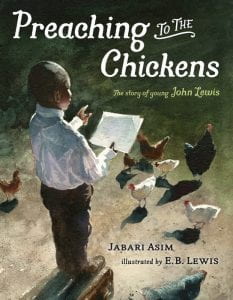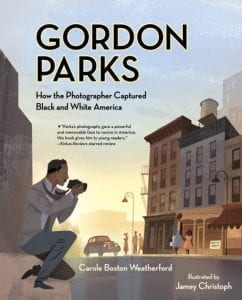 Born to parents who were both former slaves, Florence Mills knew at an early age that she loved to sing, and that her sweet, bird-like voice, resonated with those who heard her. Performing catapulted her all the way to the stages of 1920s Broadway where she inspired everyone from songwriters to playwrights. Yet with all her success, she knew firsthand how prejudice shaped her world and the world of those around her. As a result, Florence chose to support and promote works by fellow Black performers while heralding a call for their civil rights. Harlem’s Little Blackbird is a timeless story about justice, equality, and the importance of following one’s heart and dreams. Ages 3–7.
Born to parents who were both former slaves, Florence Mills knew at an early age that she loved to sing, and that her sweet, bird-like voice, resonated with those who heard her. Performing catapulted her all the way to the stages of 1920s Broadway where she inspired everyone from songwriters to playwrights. Yet with all her success, she knew firsthand how prejudice shaped her world and the world of those around her. As a result, Florence chose to support and promote works by fellow Black performers while heralding a call for their civil rights. Harlem’s Little Blackbird is a timeless story about justice, equality, and the importance of following one’s heart and dreams. Ages 3–7.
“Voice Of Freedom: Fannie Lou Hamer, Spirit Of The Civil Rights Movement” By Carole Boston Weatherford, Illustrated By Ekua Holmes
 Despite fierce prejudice and abuse, even being beaten to within an inch of her life, Fannie Lou Hamer was a champion of civil rights from the 1950s until her death in 1977. Integral to the Freedom Summer of 1964, Ms. Hamer gave a speech at the Democratic National Convention that, despite President Johnson’s interference, aired on national TV news and spurred the nation to support the Freedom Democrats. Voice of Freedom celebrates Fannie Lou Hamer’s life and legacy with a message of hope, determination, and strength. Ages 9–12.
Despite fierce prejudice and abuse, even being beaten to within an inch of her life, Fannie Lou Hamer was a champion of civil rights from the 1950s until her death in 1977. Integral to the Freedom Summer of 1964, Ms. Hamer gave a speech at the Democratic National Convention that, despite President Johnson’s interference, aired on national TV news and spurred the nation to support the Freedom Democrats. Voice of Freedom celebrates Fannie Lou Hamer’s life and legacy with a message of hope, determination, and strength. Ages 9–12.
“We Are Grateful, Otsaliheliga” By Traci Sorell, Illustrated By Frané Lessac
 The Cherokee community is grateful for blessings and challenges that each season brings. This is modern Native American life as told by an enrolled citizen of the Cherokee Nation. The word otsaliheliga (oh-jah-LEE-hay-lee-gah) is used by members of the Cherokee Nation to express gratitude. Beginning in the fall with the new year and ending in summer, follow a full Cherokee year of celebrations and experiences. Written by a citizen of the Cherokee Nation, this look at one group of Native Americans is appended with a glossary and the complete Cherokee syllabary, originally created by Sequoyah. Ages 3–7.
The Cherokee community is grateful for blessings and challenges that each season brings. This is modern Native American life as told by an enrolled citizen of the Cherokee Nation. The word otsaliheliga (oh-jah-LEE-hay-lee-gah) is used by members of the Cherokee Nation to express gratitude. Beginning in the fall with the new year and ending in summer, follow a full Cherokee year of celebrations and experiences. Written by a citizen of the Cherokee Nation, this look at one group of Native Americans is appended with a glossary and the complete Cherokee syllabary, originally created by Sequoyah. Ages 3–7.
Read more “We Are Grateful, Otsaliheliga” By Traci Sorell, Illustrated By Frané Lessac
“Preaching To The Chickens: The Story Of Young John Lewis” By Jabari Asim, Illustrated By E.B. Lewis
 John wants to be a preacher when he grows up — a leader whose words stir hearts to change, minds to think, and bodies to take action. But why wait? When John is put in charge of the family farm’s flock of chickens, he discovers that they make a wonderful congregation! So he preaches to his flock, and they listen, content under his watchful care, riveted by the rhythm of his voice. Celebrating ingenuity and dreaming big, this inspirational story includes an author’s note about John Lewis, who grew up to be a member of the Freedom Riders; chairman of the Student Nonviolent Coordinating Committee; demonstrator on the Edmund Pettus Bridge in Selma, Alabama; and Georgia congressman, who is still an activist today. Ages 4–8.
John wants to be a preacher when he grows up — a leader whose words stir hearts to change, minds to think, and bodies to take action. But why wait? When John is put in charge of the family farm’s flock of chickens, he discovers that they make a wonderful congregation! So he preaches to his flock, and they listen, content under his watchful care, riveted by the rhythm of his voice. Celebrating ingenuity and dreaming big, this inspirational story includes an author’s note about John Lewis, who grew up to be a member of the Freedom Riders; chairman of the Student Nonviolent Coordinating Committee; demonstrator on the Edmund Pettus Bridge in Selma, Alabama; and Georgia congressman, who is still an activist today. Ages 4–8.
“When We Were Alone” By David A. Robertson, Illustrated By Julie Flett
 When a young girl helps tend to her grandmother’s garden, she begins to notice things that make her curious. Why does her grandmother have long braided hair and beautifully colored clothing? Why does she speak another language and spend so much time with her family? As she asks her grandmother about these things, she is told about life in a residential school a long time ago, where all of these things were taken away. When We Were Alone is a story about a difficult time in history and, ultimately, one of resilience, empowerment and strength. Ages 4–8.
When a young girl helps tend to her grandmother’s garden, she begins to notice things that make her curious. Why does her grandmother have long braided hair and beautifully colored clothing? Why does she speak another language and spend so much time with her family? As she asks her grandmother about these things, she is told about life in a residential school a long time ago, where all of these things were taken away. When We Were Alone is a story about a difficult time in history and, ultimately, one of resilience, empowerment and strength. Ages 4–8.
Read more “When We Were Alone” By David A. Robertson, Illustrated By Julie Flett
“Gordon Parks: How The Photographer Captured Black And White America” By Carole Boston Weatherford, Illustrated By Jamey Christoph
 His white teacher tells her all-Black class, “You’ll all wind up porters and waiters”. What did she know? Gordon Parks is most famous for being the first Black director in Hollywood. But before he made movies and wrote books, he was poor and looking for work. When he bought a camera, his life changed forever. He taught himself how to take pictures and before long, people noticed. His success as a fashion photographer landed him a job working for the government. In Washington DC, Gordon went looking for a subject, but what he found was segregation. He and others were treated differently because of the color of their skin. Gordon wanted to take a stand against the racism he observed. With his camera in hand, he found a way. Told through lyrical verse and atmospheric art, this is the story of how, with a single photograph, a self-taught artist got America to take notice. Ages 4–8.
His white teacher tells her all-Black class, “You’ll all wind up porters and waiters”. What did she know? Gordon Parks is most famous for being the first Black director in Hollywood. But before he made movies and wrote books, he was poor and looking for work. When he bought a camera, his life changed forever. He taught himself how to take pictures and before long, people noticed. His success as a fashion photographer landed him a job working for the government. In Washington DC, Gordon went looking for a subject, but what he found was segregation. He and others were treated differently because of the color of their skin. Gordon wanted to take a stand against the racism he observed. With his camera in hand, he found a way. Told through lyrical verse and atmospheric art, this is the story of how, with a single photograph, a self-taught artist got America to take notice. Ages 4–8.